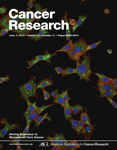ASCO2013:利用循环肿瘤细胞可检测Etirinotecan pegol治疗转移性乳腺癌的相关药效
2013-05-20 ASCO 丁香园
背景:Etirinotecan pegol (EP)为一种独特的拓扑异构酶1抑制剂,可促进对SN38的持续接触。转移性乳腺癌(mBC)患者通过EP可获得29%的总缓解率,在此基础上又针对mBC患者进行了一项全球性临床III期BEACON试验。借助于患者血样中的循环肿瘤细胞(CTC)这一最低侵袭性的方式,可实现对与药物活性相关的药效学(PD) 标记物进行检测。本研究针对在治疗前后分离到的CTC建立了
背景:Etirinotecan pegol (EP)为一种独特的拓扑异构酶1抑制剂,可促进对SN38的持续接触。转移性乳腺癌(mBC)患者通过EP可获得29%的总缓解率,在此基础上又针对mBC患者进行了一项全球性临床III期BEACON试验。借助于患者血样中的循环肿瘤细胞(CTC)这一最低侵袭性的方式,可实现对与药物活性相关的药效学(PD) 标记物进行检测。本研究针对在治疗前后分离到的CTC建立了多元定量免疫荧光分析方法,从而实现了对与EP相关的靶点特异性PD标记物进行检测。
方法:通过对照组(0.1% DMSO)及给药组(SN38, 10 uM)肿瘤细胞系(HCT116、 MCF7、 A549、SKBr3)及健康供体的PBMC,本研究建立了针对Top1、Top2、g-H2Ax、Rad51、ABCG2及Ki-67的分析方法。随后,在针对细胞角蛋白、CD45及DAPI抗体标记的孔板上,对各生物标记物的最适抗体进行了多元分析,从而对CTC进行表型鉴定。在针对BEACON患者进行的分析中,抽取到的7.5 mL系列全血样本按Apocell (德克萨斯州,休斯顿市)条件进行运输,以进行进一步处理。按ApoStream 技术,对PBMC和CTC进行分离处理。对 CTC 进行 PD 标记物染色处理,并借助配备有图像分析软件的iCys 激光扫描血细胞计数仪进行了分析。
结果:结合至肿瘤细胞的抗体表明,染色仅局限于细胞核区(Top1、Top2、g-H2AX、Ki-67)或细胞膜区(ABCG2),根据峰距可实现对其同型对照物进行区分,相关信号强度与细胞标记物表达水平的高低情况有关。目前,约80%的BEACON患者同意参加CTC子研究。截至2012年12月,已获取到了167份BEACON患者给药前血样数据。99% 的血样已得到成功处理。93%的样本可检测到CTC,中位CTC数目为216个(范围:7.5-14816个)。Top1、Top2、 g-H2Ax、Rad51、ABCG2及Ki-67染色结果呈阳性的比例分别为82%、 89%、16%、53%、 31%及52%。
结论:对于从参与BEACON 试验的患者分离到的CTC,可实现对EP靶点特异性药效生物标记物的有效测定。治疗前后样本的收集与分析工作仍在进行中。
Etirinotecan pegol (EP) target-specific pharmacodynamic (PD) biomarkers measured in circulating tumor cells (CTCs) from patients in the phase III BEACON study in patients with metastatic breast cancer (mBC).
Abstract
Background: EP is a unique topoisomerase 1 inhibitor that provides continuous exposure to SN38. EP demonstrated a 29% overall response rate in patients with mBC, leading to a phase III global BEACON study in patients with mBC. CTCs in patient blood samples provide a minimally invasive approach to detect PD markers of drug activity. We developed quantitative multiplex immunofluorescent assays to measure target-specific PD biomarkers for EP in CTCs isolated pre- and post-treatment. Methods: Assays for Top1, Top2, g-H2Ax, Rad51, ABCG2, and Ki-67 were developed using control (0.1% DMSO) and drug-treated (SN38, 10 uM) tumor cell lines (HCT116, MCF7, A549, SKBr3) and PBMCs from healthy donors. The optimal antibody for each biomarker was then multiplexed in a panel with antibodies against cytokeratin, CD45 and DAPI for phenotypic identification of CTCs. For analysis of BEACON pts, serial 7.5 mL whole blood samples were drawn and shipped ambient to Apocell (Houston, TX) for further processing. PBMCs were separated and CTCs were isolated using ApoStream technology. CTCs were stained for PD markers and analyzed using an iCys laser scanning cytometer equipped with image analysis software. Results: Antibodies bound to tumor cells showed staining confined to the nucleus (Top1, Top2, g-H2AX, Ki-67) or membrane (ABCG2), exhibited defined peak separation from their isotype controls, and signal strength correlated with cellular expression of high and low levels of markers. To date, ~ 80% of BEACON pts consent to participate in the CTC sub-study. As of 30 Oct 2012, data from 167 pre-dose blood samples from BEACON pts were available. 99% of blood samples were successfully processed. 93% had detectable CTCs, yielding a median of 216 CTCs (range: 7.5-14816). Staining was positive for Top1, Top2, g-H2Ax, Rad51, ABCG2, and Ki-67 in 82%, 89%, 16%, 53%, 31%, 52% of samples, respectively. Conclusions: EP target-specific pharmacodynamic biomarkers can be reliably measured in CTCs isolated from patients participating in BEACON. Sample collection and analysis of pre- and post-treatment samples is ongoing.
本网站所有内容来源注明为“梅斯医学”或“MedSci原创”的文字、图片和音视频资料,版权均属于梅斯医学所有。非经授权,任何媒体、网站或个人不得转载,授权转载时须注明来源为“梅斯医学”。其它来源的文章系转载文章,或“梅斯号”自媒体发布的文章,仅系出于传递更多信息之目的,本站仅负责审核内容合规,其内容不代表本站立场,本站不负责内容的准确性和版权。如果存在侵权、或不希望被转载的媒体或个人可与我们联系,我们将立即进行删除处理。
在此留言










这篇文章写得很好
163
这篇文章写得很好
161
这篇文章写得很好
148
这篇文章写得很好
185
这篇文章写得很好
168
不错的文章,学习了
120
#ASC#
64
#PE#
59
#Etirinotecan#
62
#pego#
97